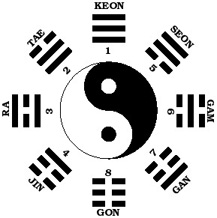Kukkiwon Taekwondo Poomsae (Patterns)
Taekwondo poomsae are a series of defending and attacking movements performed against an imaginary opponent or opponents in a set pattern. Poomsae provide both mental and physical training and are designed to aid in the development and refinement of coordination, balance, rhythm, timing and breathing control, all of which are essential skills to the Taekwondo student.

|
Various different poomsae have been devised for Taekwondo practitioners, such as the Taegeuk, the Palgwe, the Pal Jung Do and the Hyung. The Il-Gi Association practice the Taegeuk poomsae, this is the fundamental poomsae practiced by Taekwondo dojangs worldwide. Students will learn a new poomsae following each successful grading. E.g. A student promoted to 8th Kup-grade (yellow belt), will begin to learn Taegeuk Ee Jang in order to gain 7th Kup-grade (yellow belt green tag) status. |
Kup Grade Poomsae
The following are the philosophical meanings of the eight Taegeuk forms practiced by Kup-grade (coloured belt) students. Each of the eight Taegeuk forms represents an ancient trigram and derives meaning from an ancient Chinese manuscript called the "Jooyeok" in Korean, better known to us as the "I Ching" (or "Book of Changes").

The Taegeuk symbol
Taegeuk IL JANG (#1)
Heaven
(Keon = Heaven and Light) Powerful, Manly, Pure Yang.
Taegeuk Il Jang represents the symbol of "Keon", one of the 8 Kwaes (divination signs),
which means the "heaven and yang". As the "Keon" symbolizes the
beginning of the creation of all thing in the universe, so does the
Taegeuk Il Jang in the training of Taekwondo. The 8th Kup-grade (yellow
belt) trainees practice this poomsae.
Taegeuk EE JANG (#2)
Lake
(Tae = Joyful, Serene) Gentle, Firm, Feminine.
Taegeuk Ee Jang symbolizes the "Tae", one of the 8 divination signs, which signifies the
inner firmness and the outer softness. The 7th Kup-grade (yellow belt green tag) trainees practice this poomsae.
Taegeuk SAM JANG (#3)
Fire
(Ra = Fire and Sun) Variety, Passion like fire, Feminine.
Taegeuk Sam Jang symbolizes the "Ra", one of the 8 divination signs, which represent "hot
and bright". This is to encourage the trainees to harbour a sense of
justice and ardour for training. The 6th Kup-grade (green belt) trainees
practice this poomsae.
Taegeuk SAH JANG (#4)
Thunder
(Jin = Brave) Calm in the face of danger, Masculine.
Taegeuk Sah Jang symbolizes the "Jin", one of the 8 divination signs, which represent the
thunder, meaning great power and dignity. The 5th Kup-grade (green belt
blue tag) trainees practice this poomsae.
Taegeuk OH JANG (#5)
Wind
(Seon = Alternately yielding and powerful) Feminine.
Taegeuk Oh Jang symbolizes the "Seon", one of the 8 divination signs, which represent
the wind, meaning both mighty force and calmness according to its
strength and weakness. The 4th Kup-grade (blue belt) trainees practice
this poomsae.
Taegeuk YOOK JANG (#6)
Water
(Kam = Flowing) Gentle and destructive, Masculine.
Taegeuk Yook Jang symbolizes the "Kam", one of the 8 divination signs, which represents
water, meaning incessant flow and softness. The 3rd Kop-grade (blue belt
red tag) trainees practice this poomsae.
Taegeuk CHIL JANG (#7)
Mountain
(Kan = Stable, Motion and Immobility) Knowing where and when to stop, Masculine.
Taegeuk Chil Jang symbolizes the "Kan", one of the 8 divination signs, which represents
the mountain, meaning ponder and firmness. Smooth connection of
movements is important for training. The 2nd Kup-grade (red belt)
trainees practice this poomsae.
Taegeuk PAL JANG (#8)
Earth
(Kon = Strong, Concentrated) Respect, Pure Um (or Yin), Feminine.
Taegeuk 8 Jang symbolizes the "Kon", one of the 8 divination signs, which represents
"Yin" and earth, meaning the root and settlement and also the beginning
and the end. This is the last of the 8 Taegeuk poomsaes. The 1st Kup-grade
(red belt black tag) trainees practice this poomsae.
Dan Grade Poomsae
Taegeuk poomsaes from 1(il) jang to 8(pal) jang are classified as Kup grade poomsaes. The poomsaes from Koryo up to Ilyeo are Dan-grade (black-belt) poomsaes. The poomsaes consists of basic movements and they are so arranged to fit the frame of movement direction, which is called the poomsae line. The poomsae lines are described after symbols or Chinese characters.
Poomsae KORYO
Koryo poomsae symbolizes "seonbae", which means a learned man, who is
characterized by a strong martial spirit as well as a righteous learned
man's spirit. The spirit had been inherited through the ages of Koguryo,
Palhae and down to Koryo (Korea is the name of an old Korean Dynasty),
which is the background of organizing the Koryo poomsae. The line of
poomsae represents the Chinese letter which means "seonbae" or "seonbi",
a learned man or a man of virtue in the Korean language.
Poomsae KEUMGANG
Keumgang (meaning diamond) has the significance of "hardness" and "ponderosity". The Mt.
Keumgang on the Korean peninsula, which is regarded as the centre of
national spirit, and the "Keumgang yoksa" (Kumgang warrior) as named by
Buddha, who represents a mightiest warrior, are the background of
denominating this poomsae. The poomsae line symbolizes a mountain
displayed by the Chinese letter. The movements should be powerful and
well-balanced so as to befit black-belter's dignity.
Poomsae TAEBAEK
Taebaek is the name of a mountain with the meaning of "bright mountain", where Tangun,
the founder of the nation of Korean people, and the bright mountain
symbolizes sacredness of soul and Tangun's thought of "hongik ingan"
(humanitarian ideal). There are numerous sites known as Taebaek, but Mt.
Paektu, which has been typically known as the cradle of Korean people,
is the background of naming the Taebaek poomsae. The line of poomsae is
like a Chinese letter, which symbolizes the bridge between the Heaven
and the earth, signifying human beings founded a nation by the Heaven's
order.
Poomsae PYONGWON
"Pyongwon" means a plain which is a vast stretched-out land. It is the source of life for
all the creatures and the field where the human beings live their life.
The poomsae Pyongwon was based on the idea of peace and struggle
resulting from the principles of origin and use. The line of poomsae
means the origin and transformation of the plain.
Poomsae SIPJIN
The word "Sipjin" was derived from the thought of 10 longevity, which advocates there are
ten creatures of long life, namely, sun, moon, mountain, water, stone,
pine tree, herb of eternal youth, tortoise, deer, and crane. They are
two heavenly bodies, 3 natural resources, two plants and 3 animals, all
giving human beings faith, hope and love. The poomsae Sipjin symbolizes
those things. The Chinese letter meaning ten is form of the poomsae
line, which signifies an infinite numbering of the decimal system and
ceaseless development.
Poomsae JITAE
The word "Jitae" means a man standing on the ground with the two feet, looking over the
sky. A man on the earth represents the way of struggling for human life,
such as kicking, treading and jumping on the ground. Therefore, the
poomsae symbolizes various aspects occurring in the course of human
being’s struggle for existence. The poomsae line signifies a man
standing on the earth to spring up toward the heaven.
Poomsae CHONKWON
The word "Chonkwon" means the Heaven's Great Mighty, which is the origin of all
the creature and itself the cosmos. Its infinite competence signifies
the creation, change and completion. Human beings have used the name of
Heaven for all principal earthly shapes and meanings because they felt
afraid of the Heaven's mighty. Over 9,000 years ago, the founder of the
Korean people, "Chonkwon", was meant by the heavenly king. He settled
down in the heavenly town as the capital near the heavenly sea and
heavenly mountain, where the Han people as the heavenly race gave birth
to the proper thought and actions from which Taekwondo was originated.
The characteristics of movements are large actions and arm actions
forming gentle curves, thus symbolizing the greatness of Chonkwon
thought. The poomsae line "T" symbolizes a man coming down from the
heaven, submitting to the will of Heaven, being endowed power by the
Heaven and worshipping the Heaven, which means the oneness between the
Heaven and a human being.
Poomsae HANSU
The word "Hansu" means water which is the source of substance preserving the life and
growing all the creatures. Hansu symbolizes birth of a life and growth,
strongness and weakness, magnanimity, harmony, and adaptability.
Especially, "han" has the various meanings, namely, the name of a
country, numerousness, largeness, evenness, longness, even the heaven,
and the root of everything among others. Above all, the nature of water
characterized by unbreakability and flexibility, in addition to all of
the above significances, is the background of organizing this poomsae.
Actions should be practiced softly like water but continuously like a
drop of water gathering to make the ocean. The poomsae line symbolizes
the Chinese letter which means water.
Poomsae ILYEO
"Ilyeo" means the thought of a great Buddhist priest of Silla Dynasty, Saint Wonhyo, which
is characterized by the philosophy of oneness of mind (spirit) and body
(material). It teaches that a point, a line or a circle ends up after
all in one. Therefore, the poomsae Ilyeo represents the harmonization of
spirit and body, which is the essence of martial art, after a long
training of various types of techniques and spiritual cultivation for
completion of Taekwondo practice. The line of poomsae symbolizes the
Buddhist mark (swastika), in commemoration of Saint Wonhyo, which means
a state of perfect selflessness in Buddhism where origin, substance and
service come into congruity. The ultimate ideal of Taekwondo can be
found in this state. It is a discipline in which we concentrate on every
movement leaving all materialistic thoughts, obsessions and external
influences behind.
|
Taegeuk Poomsae Yellow Belt.. Il Jang |
|
Dan Grade Poomsae 1st Dan.. Koryo |

Poomsae Training
Seminar at Palatine
Leisure Centre




